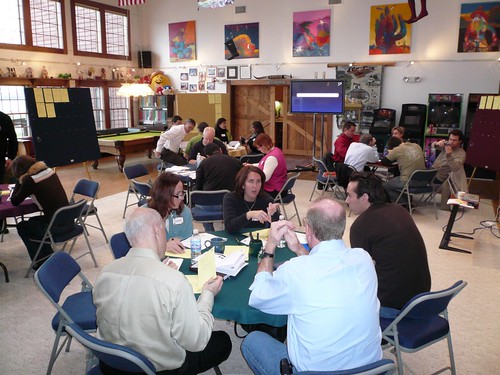People believe that opposites attract. We like to be around people who are like us when we’re working, so we end up with a one sided view of the world. This is efficient for simple, repetitive tasks because people understand each other. If you want to innovate, though, you need divergent points of view and you need other skills to implement this.
What does it mean if someone sees you differently than you see yourself – and does it matter?
If someone sees you differently than you see yourself, there a few things that happen. The
Pygmalion Effect happens. You’ll shift toward the way people see you. There was a study where students were given IQ tests. The teachers were given the top 20% scores. They tested a year later. That 20%’s IQ had increased. The interesting part is that the original 20%’s scores were randomly selected. The kids grew more because the teachers took a special interest in those supposedly top students.
People often see things in you that you don’t see. One guy saw himself as 100% Heart – a person who cares about people and relationships. Everyone else saw him as a Club – someone who takes charge and is results oriented. When we reassigned work to what he actually enjoyed, it freed him up to accelerate his connectedness with others
How is Personality Poker Played – and how is it different than other Personality tests?
Personality Poker is played with a deck of specially designed poker cards that describe different attributes. Before people arrive at an event, we’ll deal out 5 random cards to a person. People trade a card until the cards best describe their personalities. This helps them determine the partners in the innovation process. The big value, in most personality tests, is spits out colors, letters. This is more about the words people choose. It’s less about the label and more about the discussion around the word you choose. People can gift you cards in the way others see you. It’s a team dynamic where everyone is doing it at the same time. Because it’s a fun game, they have conversations that they wouldn’t have. People love to gift cards like ‘anal retentive.’ They have amazing conversations in a non-confrontational way.
In the book you mention four principles for creating high performing innovation teams. What are they?
Play to your strong suit. Each person should do what they do best. Make sure the organization plays with a full deck, meaning that there are people of different suits involved. Divide and conquer the work. Shuffle the deck to build creative tension making people work outside their usual comfort zone. Even when we divide and conquer, sometimes people need to come together to battle it out.
In Personality Poker, you say that the suits, the colors, and the numbers have meaning. What do they mean?
Spades – Analytical bunch
5-9 of Spades – people who are really smart and work more in solitary.
10-Ace of Spades – smart and like to show you, like professors.
Diamonds – They desire novelty
5-9 of Diamonds – like new ideas.
10-Ace of Diamonds – like new experiences.
Clubs – Doers
5-9 of Clubs – planners that get the job done methodically.
10-Ace of Clubs – doers that get it done, no matter what.
Hearts – Are all about the people.
5-9 of Hearts – deep relationships. Empathetic, great listeners and are typically more introverted. They also like more predictability.
10-Ace of Hearts – social butterflies and are more extroverted and more comfortable with ambiguity.
2-3-4 cards – these are the unproductive behaviors or the side effects of your strengths. A 3 of hearts can be oversensitive, for example. This is useful for determining someone’s overall personality.
Is there a Joker card?
I found out later that the court jester in court could make fun of the king. He was designed to be a contrarian. The Joker card will be in a future version.
What were some of experiences at Accenture that helped shape & prepare you to write this book?
Two things. When I worked w/ clients on innovation, I found there were “yeah, but people.” I started looking at different companies and how they innovated. Another is a personal experience. Oe year I got a big budget for an internal budget. I chose a guy much like me to co-lead the project. I’m a high Diamond, he’s a high Heart. We had a great time on the project but we got nothing done. It was a total failure. The next year, recognizing my mistake, I found an anal-retentive Club. Although he drove me crazy, we developed something successful. I appreciate the value my opposite brings and I am now intentional about choosing people like that. This can be the mistake a startup makes where they get too many similar people together and fail.
How do people get to be open enough to have conversations about personality types without feeling attacked?
When you make things fun, you can say or do anything.
Why does this stuff matter?
You don’t have to pay attention to it if you don’t want your business to grow. If you have infinite resources, then go ahead. This is about maximizing throughput and having the capacity to create new products and new services for new customers. When the pace of change outside of your organization is faster than the pace of change inside your business, you’ll be out of business.
 Welcome back! In developing your product or service to be meaningfully unique, you’ll need to leverage three additional points.
Welcome back! In developing your product or service to be meaningfully unique, you’ll need to leverage three additional points.